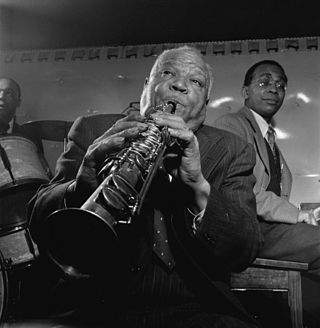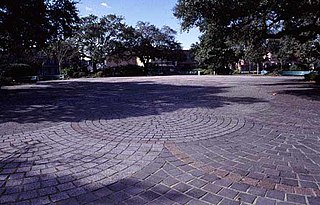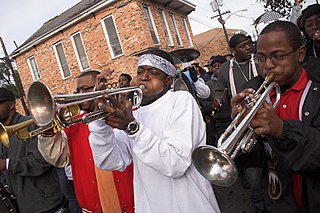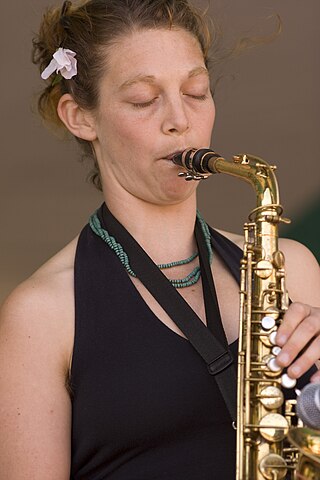Jazz is a music genre that originated in the African-American communities of New Orleans, Louisiana, in the late 19th and early 20th centuries, with its roots in blues and ragtime. Since the 1920s Jazz Age, it has been recognized as a major form of musical expression in traditional and popular music. Jazz is characterized by swing and blue notes, complex chords, call and response vocals, polyrhythms and improvisation. Jazz has roots in European harmony and African rhythmic rituals.

Charles Joseph "Buddy" Bolden was an American cornetist who was regarded by contemporaries as a key figure in the development of a New Orleans style of ragtime music, or "jass", which later came to be known as jazz.

Sidney Joseph Bechet was an American jazz saxophonist, clarinetist, and composer. He was one of the first important soloists in jazz, and first recorded several months before trumpeter Louis Armstrong. His erratic temperament hampered his career, and not until the late 1940s did he earn wide acclaim. Bechet spent much of his later life in France.
The music of Louisiana can be divided into three general regions: rural south Louisiana, home to Creole Zydeco and Old French, New Orleans, and north Louisiana. The region in and around Greater New Orleans has a unique musical heritage tied to Dixieland jazz, blues, and Afro-Caribbean rhythms. The music of the northern portion of the state starting at Baton Rouge and reaching Shreveport has similarities to that of the rest of the US South.

Senegal's music is best known abroad due to the popularity of mbalax, a development of conservative music from different ethnic groups and sabar drumming popularized internationally by Youssou N'Dour.

George Lewis was an American jazz clarinetist who achieved his highest profile in the later decades of his life.

Tremé is a neighborhood in New Orleans, Louisiana. "Tremé" is often rendered as Treme, and the neighborhood is sometimes called by its more formal French name, the Faubourg Tremé; it is listed in the New Orleans City Planning Districts as Tremé / Lafitte when including the Lafitte Projects.

The second line is a tradition in parades organized by Social Aid and Pleasure Clubs (SAPCs) with brass band parades in New Orleans, Louisiana, United States. The "main line" or "first line" is the main section of the parade, or the members of the SAPC with the parading permit as well as the brass band. The second line consists of people who follow the band to enjoy the music, dance, and engage in community. The second line's style of traditional dance, in which participants dance and walk along with the SAPCs in a free-form style with parasols and handkerchiefs, is called "second-lining". It is one of the most foundationally Black American–retentive cultures in the United States. It has been called "the quintessential New Orleans art form – a jazz funeral without a body". Another significant difference from jazz funerals is that second line parades lack the slow hymns and dirges played at funerals.
Ethno jazz, also known as world jazz, is a subgenre of jazz and world music, developed internationally in the 1950s and '60s and broadly characterized by a combination of traditional jazz and non-Western musical elements. Though occasionally equaled to or considered the successor of world music, an independent meaning of ethno jazz emerged around 1990 through the commercial success of ethnic music via globalization, which especially observed a Western focus on Asian musical interpretations. The origin of ethno jazz has widely been credited to saxophonist John Coltrane.

A jazz funeral is a funeral procession accompanied by a brass band, in the tradition of New Orleans, Louisiana.
Vocal jazz or jazz singing is an approach to jazz using the voice.

The Treme Brass Band is a marching brass band from New Orleans, Louisiana led by snare drummer Benny Jones Sr. The band, which plays traditional New Orleans-style brass band music, features a shifting lineup that has included trumpeters Kermit Ruffins and James Andrews, tenor saxophonists Elliot Callier and Frederick Sheppard, trombonist Corey Henry, and sousaphonist Kirk Joseph. Before his death in 2012, Lionel Batiste appeared consistently on the bass drum. They have released two albums, Gimme My Money Back on Arhoolie Records and I Got a Big, Fat Woman on the Sound of New Orleans Records label. The band takes its name from New Orleans' Tremé neighborhood; due to some historical confusion, the "Treme" in the name is sometimes spelled "Tremè" or "Tremé". In 2010 the Treme Brass Band performed with Uncle Lionel Batiste to play Voodoo Experience in New Orleans.

Daniel Moses Barker was an American jazz musician, vocalist, and author from New Orleans. He was a rhythm guitarist for Cab Calloway, Lucky Millinder and Benny Carter during the 1930s.

Congo Square is an open space, now within Louis Armstrong Park, which is located in the Tremé neighborhood of New Orleans, Louisiana, just across Rampart Street north of the French Quarter. The square is famous for its influence on the history of African American music, especially jazz.

A brass band is a musical ensemble generally consisting primarily of brass instruments, most often with a percussion section. Ensembles that include brass and woodwind instruments can in certain traditions also be termed brass bands, but may be more correctly termed military bands, concert bands, or "brass and reed" bands.

The music of New Orleans assumes various styles of music which have often borrowed from earlier traditions. New Orleans, Louisiana, is especially known for its strong association with jazz music, universally considered to be the birthplace of the genre. The earliest form was dixieland, which has sometimes been called traditional jazz, 'New Orleans', and 'New Orleans jazz'. However, the tradition of jazz in New Orleans has taken on various forms that have either branched out from original dixieland or taken entirely different paths altogether. New Orleans has also been a prominent center of funk, home to some of the earliest funk bands such as The Meters.
Dixieland jazz, also referred to as traditional jazz, hot jazz, or simply Dixieland, is a style of jazz based on the music that developed in New Orleans at the start of the 20th century. The 1917 recordings by the Original Dixieland Jass Band, fostered awareness of this new style of music.

Carl LeBlanc is an American guitarist and four-string banjo player. LeBlanc is most striking for his work in both avant garde jazz and traditional jazz—being the only musician to work with famed afrofuturist keyboardist/bandleader Sun Ra and Preservation Hall.

Doreen J. Ketchens is a virtuoso American jazz clarinetist who performs Dixieland and trad jazz. She has performed at concert halls, music festivals, and U.S. embassies, as well as in decades of weekly performances in Dixieland's tradition in the Royal Street Performing Arts Zone in the French Quarter of New Orleans with her band, Doreen's Jazz New Orleans. Ketchens has performed for four U.S. presidents– Bill Clinton, George H. W. Bush, Ronald Reagan, and Jimmy Carter– and was described by Nola.com in 2012 as a cultural ambassador of New Orleans.

Aurora Nealand is an American multi-instrumentalist, sound-artist and composer based in New Orleans, LA and New York City.















